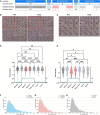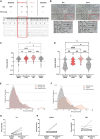Human neural network activity reacts to gravity changes in vitro
- PMID: 36968488
- PMCID: PMC10030604
- DOI: 10.3389/fnins.2023.1085282
Human neural network activity reacts to gravity changes in vitro
Abstract
During spaceflight, humans experience a variety of physiological changes due to deviations from familiar earth conditions. Specifically, the lack of gravity is responsible for many effects observed in returning astronauts. These impairments can include structural as well as functional changes of the brain and a decline in cognitive performance. However, the underlying physiological mechanisms remain elusive. Alterations in neuronal activity play a central role in mental disorders and altered neuronal transmission may also lead to diminished human performance in space. Thus, understanding the influence of altered gravity at the cellular and network level is of high importance. Previous electrophysiological experiments using patch clamp techniques and calcium indicators have shown that neuronal activity is influenced by altered gravity. By using multi-electrode array (MEA) technology, we advanced the electrophysiological investigation covering single-cell to network level responses during exposure to decreased (micro-) or increased (hyper-) gravity conditions. We continuously recorded in real-time the spontaneous activity of human induced pluripotent stem cell (hiPSC)-derived neural networks in vitro. The MEA device was integrated into a custom-built environmental chamber to expose the system with neuronal cultures to up to 6 g of hypergravity on the Short-Arm Human Centrifuge at the DLR Cologne, Germany. The flexibility of the experimental hardware set-up facilitated additional MEA electrophysiology experiments under 4.7 s of high-quality microgravity (10-6 to 10-5 g) in the Bremen drop tower, Germany. Hypergravity led to significant changes in activity. During the microgravity phase, the mean action potential frequency across the neural networks was significantly enhanced, whereas different subgroups of neurons showed distinct behaviors, such as increased or decreased firing activity. Our data clearly demonstrate that gravity as an environmental stimulus triggers changes in neuronal activity. Neuronal networks especially reacted to acute changes in mechanical loading (hypergravity) or de-loading (microgravity). The current study clearly shows the gravity-dependent response of neuronal networks endorsing the importance of further investigations of neuronal activity and its adaptive responses to micro- and hypergravity. Our approach provided the basis for the identification of responsible mechanisms and the development of countermeasures with potential implications on manned space missions.
Keywords: drop tower; electrophysiology; human induced pluripotent stem cell (hiPSC)-derived neurons; hypergravity; iNGN; microgravity; multi-electrode array (MEA); neural network.
Copyright © 2023 Striebel, Kalinski, Sturm, Drouvé, Peters, Lichterfeld, Habibey, Hauslage, El Sheikh, Busskamp and Liemersdorf.
Conflict of interest statement
The authors declare that the research was conducted in the absence of any commercial or financial relationships that could be construed as a potential conflict of interest.
Figures



Similar articles
-
The brain in micro- and hypergravity: the effects of changing gravity on the brain electrocortical activity.Eur J Sport Sci. 2014;14(8):813-22. doi: 10.1080/17461391.2014.908959. Epub 2014 Apr 15. Eur J Sport Sci. 2014. PMID: 24734884 Review.
-
Parabolic, Flight-Induced, Acute Hypergravity and Microgravity Effects on the Beating Rate of Human Cardiomyocytes.Cells. 2019 Apr 14;8(4):352. doi: 10.3390/cells8040352. Cells. 2019. PMID: 31013958 Free PMC article.
-
The oxidative burst reaction in mammalian cells depends on gravity.Cell Commun Signal. 2013 Dec 20;11:98. doi: 10.1186/1478-811X-11-98. Cell Commun Signal. 2013. PMID: 24359439 Free PMC article.
-
Microgravity decreases and hypergravity increases exhaled nitric oxide.J Appl Physiol (1985). 2009 Nov;107(5):1431-7. doi: 10.1152/japplphysiol.91081.2008. Epub 2009 Sep 10. J Appl Physiol (1985). 2009. PMID: 19745185
-
The development of gravity sensory systems during periods of altered gravity dependent sensory input.Adv Space Biol Med. 2003;9:133-71. doi: 10.1016/s1569-2574(03)09006-3. Adv Space Biol Med. 2003. PMID: 14631632 Review.
Cited by
-
Influence of microgravity on spontaneous calcium activity of primary hippocampal neurons grown in microfluidic chips.NPJ Microgravity. 2024 Feb 6;10(1):15. doi: 10.1038/s41526-024-00355-x. NPJ Microgravity. 2024. PMID: 38321051 Free PMC article.
-
Adoption of microfluidic MEA technology for electrophysiology of 3D neuronal networks exposed to suborbital conditions.NPJ Microgravity. 2025 May 27;11(1):20. doi: 10.1038/s41526-025-00476-x. NPJ Microgravity. 2025. PMID: 40425594 Free PMC article.
-
Omics Studies of Specialized Cells and Stem Cells under Microgravity Conditions.Int J Mol Sci. 2024 Sep 17;25(18):10014. doi: 10.3390/ijms251810014. Int J Mol Sci. 2024. PMID: 39337501 Free PMC article. Review.
-
Simulated microgravity impairs human NK cell cytotoxic activity against space radiation-relevant leukemic cells.NPJ Microgravity. 2024 Aug 14;10(1):85. doi: 10.1038/s41526-024-00424-1. NPJ Microgravity. 2024. PMID: 39143086 Free PMC article.
References
-
- Babiloni C., Blinowska K., Bonanni L., Cichocki A., De Haan W., Del Percio C., et al. (2020). What electrophysiology tells us about Alzheimer’s disease: a window into the synchronization and connectivity of brain neurons. Neurobiol. Aging 85 58–73. 10.1016/J.NEUROBIOLAGING.2019.09.008 - DOI - PubMed
LinkOut - more resources
Full Text Sources

